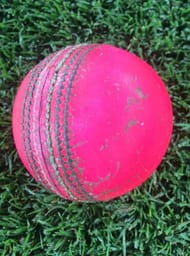History has just been made at the Eden Gardens when Ravikant Singh of Bhowanipore bowled the first ball of the CAB Super League final to Jayojit Basu of Mohun Bagan – the first official delivery on Indian soil with a pink ball. Mohammed Shami and Wriddhiman Saha will be among the 22 Indian players who will be the first set of players in the country to get a taste of this new setting over the next few days.
Everybody associated with cricket has one big question on their minds right now – will pink ball cricket be a path-breaking step in the evolution of the sport, or will it be consigned to history as one of the innovations which could find no legitimate place – like the super sub, which had been in vogue in limited overs cricket a few years earlier.
The organisers of India’s first ever match with this ball, among whom Sourav Ganguly’s has been the leading voice, have stressed on the fact that no conclusion should be drawn before the experiment is actually carried out. However, with an eye on Indian conditions especially, there are some specific issues which will be kept a wary eye on.
Longevity of pink ball
One of the most common concerns about the pink ball has been that it does not last as long as would be required for a ball in the longer formats, where a change of ball is stipulated after a minimum of 80 overs. It has been said by players after the Adelaide Day/Night Test between Australia and New Zealand that the ball gets scuffed up faster, loses its shape and colour, and almost gets difficult for bowlers to grip as well as for batsmen to hit it cleanly.
One of the first issues raised when day/night Test cricket was planned in India was that the grounds in India are more abrasive than Adelaide, and that the ball would be scuffed up even before it had in Australia. There is a possibility that the pink ball will start showing black spots, which might be hard for the batsmen to negotiate under lights.
Adam Voges was one of the batsmen who had spoken against the pink ball’s tendency of getting “chewed up”, saying, “There wasn’t much pink left on it at the end of the game.”
Sourav Ganguly has promised in the lead-up to the CAB Super League final that special care has been taken to increase the longevity of the pink ball. The ground has been specially conditioned, the practice pitches have been made green.
Spinners at disadvantage
In the Quad-e-Azam Cup final, which was held under lights in Pakistan with a pink ball, 27 of the 32 wickets that fell were taken by fast bowlers. In the Adelaide Test, which got over in three days, 29 wickets were claimed by fast bowlers.
Spinners have not yet bowled on Indian pitches with this new ball, but could the limited sample of results we have had indicate that it is a possibility that India might lose their advantage of spin bowling if pink ball cricket comes in vogue?
Another issue that could be faced in India is the amount of dew, which might take spinners out of the equation as the night wears on.
Asked about this, VVS Laxman has said that spinners will probably need to come up with new innovations, but he does not think that there will be too much of a change in spinners’ contribution on Indian pitches.
And as Ganguly has said, all doubts pertaining to this will remain until the day Ravichandran Ashwin takes a six-wicket haul with the ball, after which everybody shall be a vocal advocate of a theory that the pink ball actually assists spinners.
Difficulties for batsmen
On proof of what has been at the Eden Gardens so far and what has been said by players who have had to face a new pink ball spell, one thing is very evident – this ball swings around like nobody’s business, especially in the first few overs. What is more, the seam of the pink ball has been said to be hard to spot as well, not giving batsmen a chance to know which way the ball will swing as well.
From David Warner to AB de Villiers, all batsmen around the world have been united in being sceptical of the pink ball.
In the Australia-New Zealand Test series in which the pink ball had its first international outing, 1432 runs were scored at Brisbane, 1672 runs were scored at Perth, but the Adelaide Test saw only 832 runs, and that too with all 4 innings getting over within three days. In the Quad-e-Azam Cup final, which featured Younis Khan, Misbah-ul-Haq, Mohammad Hafeez, Azhar Ali and Umar Akmal, there were no centuries.
In the small passage of play possible at the CAB Super League final before rain came down to interrupt play, Mohun Bagan had already lost their first wicket, heading into safety with the score at 9/1. Some practice is definitely required before Indian batsmen are comfortable with this novelty.
Visibility during dusk

One of the things that the players cannot get used to even with practice is the visibility of the pink ball during sunset hour, when the floodlights and the slanting rays of the sun create a difficult light for the ball to be spotted.
Not only have batsmen complained of this phenomenon, outfield fielders have also said that it is impossible to spot the pink ball against the sky in fading light. In the Adelaide Test, it had been said that it was especially difficult to field at square leg, while the visibility was much better in front of the wicket during twilight.
One possible solution to this is to have a long break when the twilight hour is scheduled. This hour will of course vary according to the venue of the match. Another, more far-fetched solution, which will also be a solution to some other impediments as well, is to reintroduce the closed-roof stadium seen in Australia in 2000 for an ODI against South Africa.
Disadvantage with Kookabura balls

One problem specific to Indian conditions is that the kookabura ball, which is currently the manufacturers of the pink ball, is not suited to Indian conditions. The BCCI is in talks with other suppliers of the ball, but for now, they have to make do with importing the ball normally used in Australia.
There is a concern with the seam of the kookabura ball as well, the thread of which disappears very fast as the ball grows older.
Twelve kookabura balls have been brought to the Eden Gardens for the CAB Super League final. It is hoped that the balls last the duration of the match, and that there is not too much of a difference in how the game progresses depending on the makers of the ball.
Looking for fast live cricket scores? Download CricRocket and get fast score updates, top-notch commentary in-depth match stats & much more! 🚀☄️




